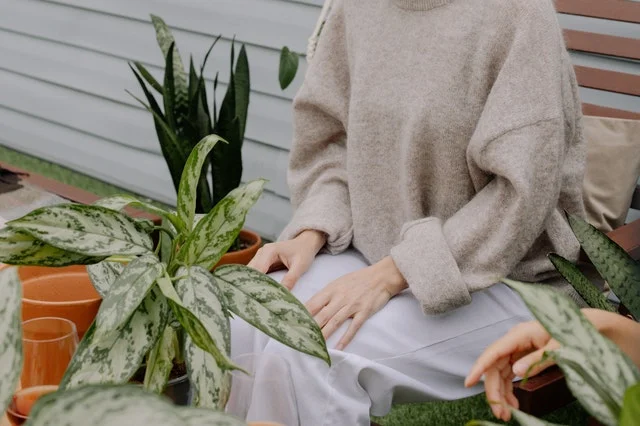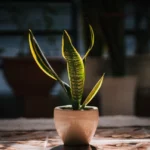As with all plants, when you have a snake plant, you want it to look lovely at all times. This is why, when you notice the leaves curling, you’ll want to get that problem sorted as soon as possible.
Snake Plant leaves can curl inwards or outwards, and the curls can be wrinkly or flat, sometimes with brown tips.
The most common causes of curling leaves are underwatering, overwatering, lack of sunlight, too much fertilizer, the wrong temperature, the wrong pH of soil, and pests/diseases.
To solve curling leaves, you’ll need to water it enough (but not too much), have a soil Ph of 5.5-7.5, and put it into the right environment.
Table of Contents
What Leaf Curling looks like
Let’s start off by talking about what curling leaves look like. Unlike other issues, such as root rot, you can tell when you have curling leaves because… well… the leaves will curl.
Sometimes the leaves will curl inwards, and other times, they will curl outwards. The curling direction will rarely tell you anything, and most of the time, it will just be random.
Besides curling, unhealthy leaves may also be wrinkled, and they may also have brown tips on them. This is usually a sign of a water issue.
Causes of Leaf Curling
Under watering
Plants are living things, and therefore they need to be cared for if they are to thrive. One issue that some plant owners have is that they forget to water them. Remember, every cell of the plant is mainly made up of water, so without water, the plant will not be able to perform any of its functions.
Not only does the water make up most of the plant, but it is also responsible for carrying the nutrients that allow it to repair itself. No water means no nutrients. No nutrients mean the cells will not be able to replace themselves.
Over Watering
Just as not watering it enough can lead to problems, so can overwatering it. Each plant has a limit to the amount of water it can absorb. Too much water, and instead of being drunk by the plant, it will simply sit around the roots. This will clog them up and prevent them from being able to take in any more nutrients.
Think of it like this, if you fill a balloon with water, eventually, you won’t be able to fit any more water in. Unlike a balloon which will pop, a plant will simply stop taking in water.
Lack of Light
As some of you may remember from school, light is like food to the plant. Through photosynthesis, the plant can take in sunlight and turn it into energy. However, if there is not enough sunlight, the plant will have nothing to turn into energy.
With a lack of energy, the cells won’t repair themselves, and the chances of the leaves curling will increase. This is why you rarely see plants growing inside dark caves, but they thrive in warm places such as rain forests.
Too much fertiliser
Many plant owners know that their plants will need fertilizers. In the wild, plants get fertilized when other plants die and leak their nutrients into the soil. But at home, you need to give your plants a helping hand.
However, just as plants have a limit to the amount of water they can take, they also have a limit to the amount of fertilizer they can take in. Adding too much fertilizer will mean that the plant will just stop absorbing any fertilizer. They won’t take in any nutrients and quickly lead to the leaves curling in.
Wrong Temperature
Plants tend to be very fickle things, and if just one thing is off, the whole thing decides it doesn’t want to be alive anymore- and no, I’m not going to make a cheap Gen Z joke here!
When the temperature is too high, the water will evaporate into the air very quickly. If there isn’t enough water to replace it, the cells will simply die out.
But on the flip side of that, when the temperature is super low, the water in the cells can freeze. Organelles encased in a block of ice will not be able to perform their functions.
Wrong soil pH
As plants are fickle things, the soil’s pH can also determine how well it grows. The pH of the soil determines the amount of nutrients within it.
One of the critical nutrients that plants love is magnesium. Without magnesium, most plants would not be able to survive. But some soils can be too acidic, also known as “having a low pH”.
Magnesium doesn’t do too well in acid. So, if the acid kills the magnesium, the plant won’t be able to absorb it.
Not enough nutrients? Cells are not able to make repairs, and the leaves start to curl.
Pests and Diseases
Pests can come from a variety of sources. Some may have been stowaways on your snake plant or other plants. Some might have been picked up by you on your daily walk. The same can be said for pathogens and fungal infections.
With Snake Plants, the most common types of pests are spider mites and mealybugs. These are very tiny bugs that you can just about see with the naked eye.
But a widespread kind of fungal infection is root rot, most commonly caused by an overabundance of water.
Solutions to Curling Leaves
How often should you water your Snake Plant?
To avoid over or under watering your plant, you will need to know how often to water it. The answer is.. it depends.
Generally speaking, you should be watering your snake plant very 2-8 weeks. However, the exact frequency of the ideal water will depend on several factors including, size, environment, and type of snake plant.
Instead of having a schedule, it will be better to water it when it needs watering. You can tell when your plant is thirsty when the top 2 inches of the soil are dry. If it’s still wet, your Snake Plant still hasn’t absorbed all of the water from last time.
What is the ideal soil for a Snake Plant?
Getting the soil right is also essential in avoiding leaf curling. As we’ve already spoken about, the pH levels need to perfect. The best pH levels for snake plant soil is between 5.5 and 7.5.
As well as not being too acidic, it also needs to be well-draining. If the water can’t drain throughout the soil, it will stagnate around the roots and increase the chances of root rot. And be sure to put it into a large enough pot too!
Not enough pot for the roots will mean the water will pool around them.
And of course, make sure it’s not too wet.
How to care for a Snake Plant
If you care for your snake plant properly, you can drastically drop the chances of the leaves curling. Make sure the temperature is between 55-75F to prevent the water from either freezing or evaporating.
With the fertilizer, you only need to feed it once a month. That should only be during the summer when it’s best able to absorb the nutrients- although some kinds of snake plants may need to be fertilized more or less often.
Be sure to water it enough, but not too much.
How to avoid root rot
One of the most common issues with Snake Plants is root rot. If you suspect that your plant has root rot, there are several steps you can take to solve it.
Firstly, try moving it to a bigger pot with better draining soil.
If the room it lives in is too humid, you might want to consider putting it in a room with less water in the air.
Make sure it’s at the (rather big) goldilocks zone of 55-75F.
But the most common cause of root rot is plant parents overwatering their snake plants.
How to kill bugs on the Snake Plant
If you notice bugs on your plant, of course, it’s annoying, but it’s also a pretty easy give away as to the cause of the leaves curling.
Mealybugs are horrible because they have a hard shell that protects them from any pesticide. With these guys, I’m afraid your only option is to take off the leaves where they’re living.
With other pests, such as spider mites, you can use an insecticide spray and spray it on the leaves. Just make sure it’s diluted, as a powerful insecticide may kill the plant as well as the bugs.
Conclusion
Snake Plants are some of the most popular house plants. This is why we can get so annoyed when they have leaves that curl up. There are many reasons why this might happen; too much water, not enough water, too hot, too cold, wrong soil, wrong size pot, pests, diseases, not enough sunlight, too much fertilizer, not enough fertilizer.
However, unlike some other problems that plants might get, the great thing about curling leaves is that it doesn’t mean game over. You just need to figure out what’s wrong with it and take the appropriate steps to get it sorted.
Once that’s all done, your plant will be well on the way to being a beautiful and vibrant plant once again. And you can show off how great of a plant parent you are.



